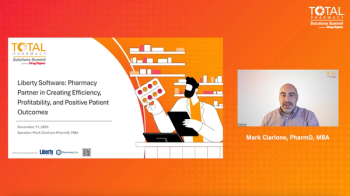
Health literacy tools in the pharmacy
Using verbal, written, and visual communication strategies, pharmacists can empower patients with limited health literacy to manage complex medication regimens.
Katie Scarpace SchroederA couple came into my pharmacy after one was discharged from the hospital. They carried a folder overflowing with directions and educational handouts. As I conducted the comprehensive medication review (CMR), I learned that the patient had not initiated any of the recent medication changes.
The couple described medications by appearance and disease states by symptoms. It did not take long for me to realize that inadequate health literacy was causing this couple to struggle with management of the patient’s medications.
We’ve all encountered this patient. As the medication regimen becomes increasingly complex, it can become challenging to provide health information to a patient with inadequate health literacy.
However, there are verbal, written, and visual communication strategies that pharmacists can implement to empower patients who must manage complex medication regimens.
Verbal strategies
Verbal communication is the main form of communication employed by pharmacists during a CMR.
The
The pharmacist can assess the knowledge gained by the patient through use of the teach-back method, in which the patient explains the information and instructions received back to the pharmacist.2
Written communications
To reinforce the main topics discussed during the CMR, it is essential to provide patients with written explanations, including medication action plans.
Four types of words should be avoided, as they can cause patients with inadequate health literacy to misunderstand what is being said1. These include medical terminology, abstract concepts, categorical references, and value judgments. Figure 1 shows examples of what to avoid and alternatives that are preferable.
More suggestions on
In addition to careful word choice, oversimplification is another concern. It is important to avoid oversimplifying written information, because the result can deepen misunderstanding. The omission of words creates information gaps that require patients to attempt to interpret what is missing.
Visual explanations
Lastly, the pharmacist can incorporate visual explanations during the CMR. Diagrams and models can expand the patients understanding of the disease state.
Also, as you describe specific medications, use the patient’s medication vials to provide the patient with a visual connection to your explanation.
As switching between generic manufacturers becomes commonplace, it is vital to perform “show and tell.” The show-and-tell technique requires the pharmacist to exhibit each medication to the patient during the consultation.
Sticker descriptions may be helpful to some patients when their medications are being switched to alternate manufacturers, but for many patients with inadequate literacy, the stickers may be incomprehensible.
Pill cards
When you are creating a usable medication list for a patient with inadequate health literacy, pill cards are an ideal strategy to employ, because they combine verbal, written, and visual communications. Pill cards include the name of the medication, its purpose, how much to take, and when to take it3.
In creating the pill card, the pharmacist combines short phrases with images4. Instructions and tools for creating pill cards can be found at the
Pill cards work well for scheduled medications. Medications that are taken “as needed” should not be included, as the patient may misread the instruction and assume that the medication is scheduled.3
For patients who recognize medications by appearance, it may be tempting to include an image of the pill3. However, as the source for the medication changes, it can be difficult to keep the pill card updated. To ensure that the patient uses the pill card correctly, the pharmacist should make clear to the patient the way that information is organized on the pill card.
When created correctly, this tool employs verbal, written, and visual strategies to empower patients to organize their medication regimens.
As I worked with my discharged hospital patient, I used the above strategies. The patient’s doctor subsequently called me and thanked me for helping the patient understand his new medication regimen. With tools such as these, pharmacists do have the skills to empower patients to manage complex medication regimens.
References
1. National Patient Safety Foundation. Ask Me 3.
2. Johnson JL, Moser L, Garwood CL. Health literacy: A primer for pharmacists. Am J Health Syst Pharm. 2013;70:949–955.
3. How to create a pill card. Feb 2008. Agency for Healthcare Research and Quality, Rockville, MD.
4. Kripalani S et al. Development of an illustrated medication schedule as a low-literacy patient education tool. Patient Education and Counseling. 2007;66:368-377.
Katie Schroederis a PGY-1 community practice resident at the University of Wisconsin-Madison School of Pharmacy at The Medicine Shoppe in Two Rivers, Wis.E-mail her at kscarpace@wisc.edu.
Newsletter
Pharmacy practice is always changing. Stay ahead of the curve with the Drug Topics newsletter and get the latest drug information, industry trends, and patient care tips.











































































































































































































